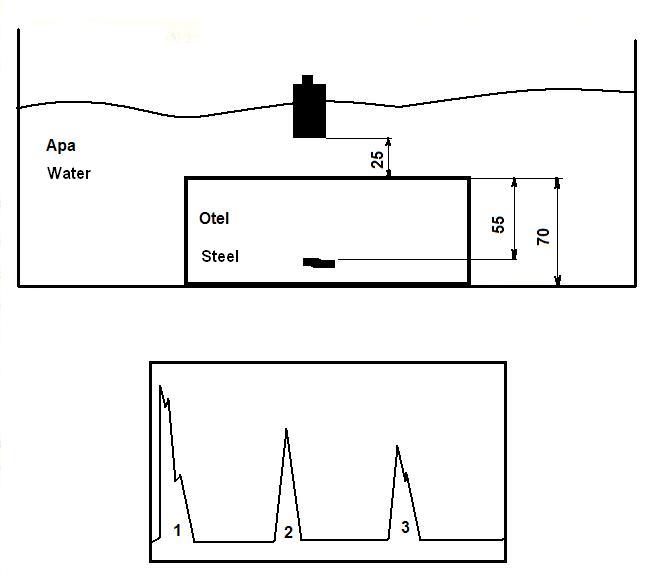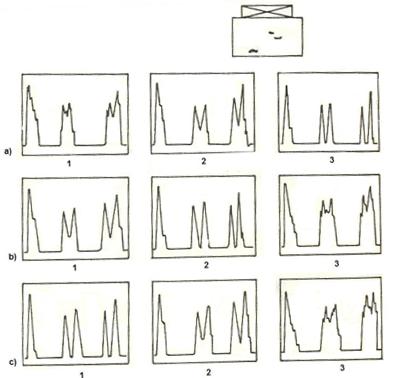|
Mark the correct answer |
1. If wave transmitted through particles moving inside medium are parallel with the sense of corrugated moving, the wave is called: |
|
2. The procedure that permit to balance the ultrasound device with calibrated block device is named: |
|
a)
correlation
|
3. Cracks, inclusions, blow holes, etc competent to made reflection of ultrasound energy can be considered in expression: |
|
|
4. The ultrasound transducer that transmits ultrasound waves through 0 degree angle with the normal of tested surface is called: |
|
a)
double transducer
b)
surface wave transducer
c)
skew transducer
d)
normal transducer
|
5. Through liquid can be propagated: |
|
a)
longitudinal waves
b)
transversal waves
c)
a and b
d)
in liquids ultrasound waves aren't propagated
|
6. The echo that emerging on oscilloscope display, that is reflecting on opposite surface in report with penetration surface of the examination material, is called: |
|
a)
echo
b)
noise echo
c)
emitting impulse
d)
back-wall echo
|
7. The compound that separates the emission surface of ultrasound transducer from examination surface of material and permits to ensure or improve the transmission of ultrasound waves, is named: |
|
a)
lubricant
b)
coupling medium
c)
damping body
d)
coating film
|
8. In checking through immersion we balance, ultrasound transducer position, for conducting ultrasound waves through examination probe under different angles in report with frontal surface. This procedure is called: |
|
a)
examination under skew incidence
b)
examination through reflection
c)
examination through immersion
d)
examination through direct contact
|
9. The compound that permit to reduce superficial effort on liquid use in immersion examination, is called: |
|
a)
coupling
b)
moisten agent
c)
tension active agent
d)
adapter
|
10. On immersion examination, ultrasound energy are conducting from ultrasound transducer to penetration surface of product, only by longitudinal waves, because : |
|
a)
longitudinal waves have speed propagation greatest in report of other waves types, permitting in this way to reduce the distance from transducer to penetration surface, on oscilloscope display
b)
In liquids are transmitted only longitudinal waves
c)
transversal waves generates air bubbles
d)
no correct answer
|
|
Mark the correct answer |
1. In the figure 1 is presented immersion examination for a steel block that has inside a discontinuity. What represent the impulse number 1 in the figure? |

|
|
a)
first echo
b)
initial impulse
c)
first echo from discontinuity
d)
first back-wall echo
|
2. Impulse number 2 from the figure 1 represent: |
|
a)
first echo reflected from frontal surface
b)
initial impulse
c)
first echo from discontinuity
d)
first back-wall echo
|
3. In figure 1, the distance that separate the signals 1 and 2 represents: |
|
c)
the distance between ultrasound transducer and the steel block
|
4. On immersion examination, multiple echoes resulting from frontal surface of checked probe that are preceding the first back-wall echo, can be exclude: |
|
a)
using different frequency
b)
using cylindrical ultrasound lens
c)
increasing the height of water that separate the ultrasound transducer and the examination probe
d)
decreasing the amplification of ultrasound device
|
5.On immersion examination, the proof that the ultrasound transducer is normal on penetration surface is given by: |
|
a)
maximum height of reflected echo from penetration surface
b)
maximum amplitude of initial impulse
c)
missing multiple echoes resulting from penetration surface
d)
the moment when transducer is normal at penetration surface can not be determined
|
6. Which oscillogram given below in the figure 2 is correct? We suppose that the product is examined with an assembly device-ultrasound transducer that have a resolution: |
 |
|
|
7.The discontinuity presented in majority of forgeable pieces have the tendency to be oriented: |
a)
transverse in report with oriented grains
b)
perpendicularly on examination surface
c)
in the sense of oriented grains
d)
chaotic |
[1] Petculescu P., "Controlul sudurii si constructiilor sudate", Constanta, 1985, agreed by ISCIR.